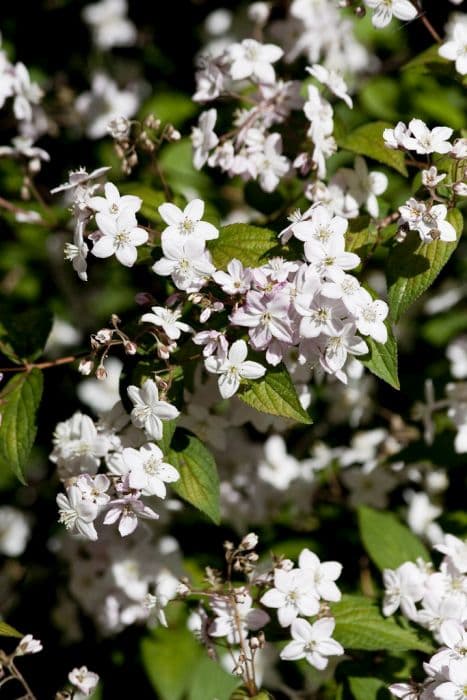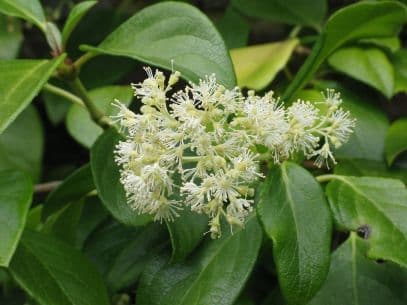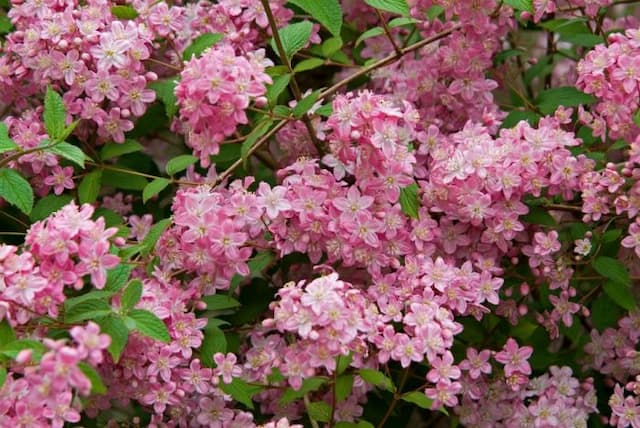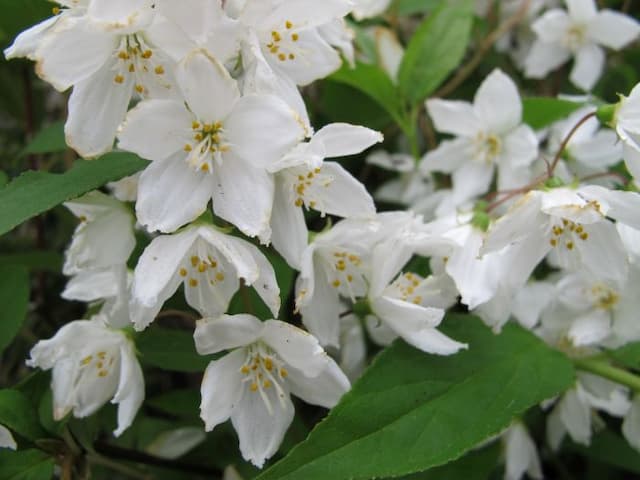Smooth Hydrangea Hydrangea arborescens Pink Annabelle = 'Ncha1' (PBR)
![hydrangea [Pink Annabelle] ('Ncha1')](/_next/image?url=https%3A%2F%2Fplants-admin.emdemapps.com%2Fimages%2Fplants%2F%2Fimages%2F604b576c63619.png&w=3840&q=75)
ABOUT
The Hydrangea arborescens Pink Annabelle, commonly known as the Smooth Hydrangea, features a striking appearance characterized by large flower heads. These blooms emerge as soft green globes before maturing into a vibrant pink color. The flowers possess a rounded shape and are notably large, creating a showy display that stands out in the garden. The plant itself has sturdy, upright stems that hold the flower heads aloft, ensuring they make a strong visual impact even from a distance. The foliage of the Smooth Hydrangea is dark green, providing a lush backdrop for the pink blooms. The leaves are broad with a somewhat coarse texture, forming a dense shrub that fills out the space it occupies. As seasons change, so does the color of the flowers, with hues that can evolve and deepen over time, offering a changing palette in the landscape. Overall, Pink Annabelle is a highly ornamental plant that offers a dramatic and colorful presence among garden plantings.
About this plant
 Names
NamesFamily
Hydrangeaceae
Synonyms
Pink Annabelle Hydrangea, Smooth Hydrangea, Wild Hydrangea, Sevenbark
Common names
Hydrangea arborescens Pink Annabelle = 'Ncha1' (PBR).
 Toxicity
ToxicityTo humans
The common smooth hydrangea or wild hydrangea can be toxic if ingested due to the presence of cyanogenic glycosides. These compounds can release cyanide in the body when the plant is chewed and digested. Symptoms of hydrangea poisoning in humans may include stomach upset, nausea, vomiting, and diarrhea. In some cases, more severe symptoms could occur, such as dizziness, rapid pulse, drop in blood pressure, and even convulsions. The highest concentrations of toxic substances are typically found in the leaves and buds of the plant.
To pets
Smooth hydrangea is also toxic to pets. The plant contains cyanogenic glycosides that can release cyanide when ingested, leading to poisoning. The signs of smooth hydrangea poisoning in pets may include gastrointestinal symptoms such as vomiting, diarrhea, and abdominal pain. Other possible effects are lethargy, depression, and confusion. In severe cases, poisoning could lead to more serious symptoms such as difficulty breathing, increased heart rate, and seizures. The toxicity level can vary, with the highest concentration usually in the leaves and buds of the plant. It is advised to keep pets away from the plant to prevent accidental ingestion.
 Characteristics
CharacteristicsLife cycle
Perennials
Foliage type
Deciduous
Color of leaves
Green
Flower color
Pink
Height
4-5 feet (1.2-1.5 meters)
Spread
4-5 feet (1.2-1.5 meters)
Plant type
Shrub
Hardiness zones
3-9
Native area
Southeastern United States
Benefits
 General Benefits
General Benefits- Attractive Flowering – The hydrangea arborescens Pink Annabelle boasts large, attractive pink blooms that add color and visual interest to the garden.
- Extended Blooming Season – It typically flowers from early summer into fall, providing a long-lasting display.
- Low Maintenance – The plant is relatively easy to care for, requiring minimal pruning and upkeep once established.
- Drought Tolerance – While it prefers moist soil, once established, it can tolerate periods of drought better than some other hydrangeas.
- Pest and Disease Resistance – This cultivar is generally resistant to many common pests and diseases, reducing the need for chemical treatments.
- Adaptability – It can adapt to a variety of soil types, though it prefers well-drained, moist soils.
- Wildlife Attraction – The flowers can attract pollinators such as bees and butterflies, contributing to the health of your garden ecosystem.
- Versatility in Landscaping – Suitable for mixed borders, foundation plantings, and as a specimen plant, providing flexibility in garden design.
- Cold Hardiness – The Pink Annabelle is capable of withstanding colder climates, making it suitable for a range of regions.
- Supports Erosion Control – The hydrangea’s root system can help prevent soil erosion in sloped or problem areas of the garden.
 Medical Properties
Medical PropertiesThis plant is not used for medical purposes.
 Air-purifying Qualities
Air-purifying QualitiesThis plant is not specifically known for air purifying qualities.
 Other Uses
Other Uses- Flower Drying: Pink Annabelle hydrangeas can be dried and used to create long-lasting floral arrangements that maintain their color and form, providing a touch of elegance to home decor.
- Photography Prop: Due to their large, vivid blooms, Pink Annabelle hydrangeas are often used as a stunning natural backdrop for portrait and garden photography.
- Edible Art Garnish: Although not a common practice, the petals of Pink Annabelle hydrangeas can be used as an ornamental decoration on cakes and desserts, provided they are free of pesticides.
- Color-changing Experiment: The flowers of the Pink Annabelle hydrangea can change color from pink to blue depending on soil pH levels, making them a useful educational tool for demonstrating soil chemistry.
- Fabric Dyeing: The blooms of Pink Annabelle hydrangeas can be used to create a natural dye for fabrics, offering a range of pink hues.
- Craft Projects: Dried Pink Annabelle hydrangea flowers can be used in craft projects, such as making wreaths, greeting cards, or potpourri.
- Living Fences: When planted in rows, Pink Annabelle hydrangeas can form dense hedges that provide privacy and reduce noise, serving as a decorative living fence.
- Wedding Decor: Pink Annabelle hydrangeas are commonly used in wedding bouquets and centerpieces due to their full, lush clusters of flowers that add a romantic touch to the celebration.
- Theme Gardens: These hydrangeas can be the centerpiece of a monochromatic or pastel-themed garden, attracting visitors who appreciate its striking blooms.
- Bee and Butterfly Garden: Pink Annabelle hydrangeas contribute to biodiversity by attracting pollinators such as bees and butterflies, helping to sustain a healthy ecosystem.
Interesting Facts
 Feng Shui
Feng ShuiThe Hydrangea is not used in Feng Shui practice.
 Zodiac Sign Compitability
Zodiac Sign CompitabilityThe Hydrangea is not used in astrology practice.
 Plant Symbolism
Plant Symbolism- Heartfelt Emotions: Hydrangeas often symbolize deep feelings and heartfelt emotions, particularly gratitude and understanding.
- Abundance: With their lush, round flower heads, hydrangeas can represent abundance and prosperity.
- Vanity: In some cultures, hydrangeas can symbolize vanity or boastfulness due to their expansive blooms and rich appearance.
- Grace and Beauty: The elegant shape and form of the hydrangea's flowers convey grace and enduring beauty.
- Fourth Wedding Anniversary: Hydrangeas are a traditional gift for the fourth wedding anniversary, symbolizing appreciation and lasting love.
 Water
WaterThe Smooth Hydrangea 'Pink Annabelle' prefers consistently moist soil, so it should be watered deeply once a week. However, during periods of drought or extreme heat, increase watering to twice per week, providing approximately 1-1.5 gallons of water per session. The plant benefits from a slow and thorough watering method, where water is applied directly to the base to ensure that it reaches the roots, rather than just wetting the surface. Monitor the soil moisture level regularly and adjust your watering accordingly, as overwatering can be just as detrimental as under-watering.
 Light
LightSmooth Hydrangea 'Pink Annabelle' thrives best in partial shade to filtered sunlight, particularly in the afternoon when the sun is most intense. Ideally, situate the plant where it can receive morning sunlight and enjoy shade during the hot afternoon hours. Too much direct sunlight can cause scorching of the leaves, while too little will diminish blooming.
 Temperature
TemperatureSmooth Hydrangea 'Pink Annabelle' prefers a temperate climate and can survive in a temperature range of approximately 30°F to 80°F. The ideal temperature range for this plant is typically between 50°F and 70°F. Harsh winter conditions may require additional protection or mulching to shield the roots from extreme cold.
 Pruning
PruningPrune the Smooth Hydrangea 'Pink Annabelle' in late winter or early spring before new growth starts to rejuvenate the plant and encourage more substantial blooms. The plant can be cut back by about one-third of its size. Pruning promotes healthy growth and larger flower heads, and because it blooms on new wood, annual pruning won't affect flowering.
 Cleaning
CleaningAs needed
 Soil
SoilSmooth Hydrangea 'Pink Annabelle' prefers well-draining, rich, loamy soil with consistent moisture. A soil mix with equal parts garden soil, peat moss, and perlite is ideal. The optimal pH range for this plant is slightly acidic to neutral, around 5.5 to 7.0.
 Repotting
RepottingSmooth Hydrangea 'Pink Annabelle' should be repotted every 3 to 5 years, or when it outgrows its current container. Spring is the best time for repotting to allow the plant to establish in the growing season.
 Humidity & Misting
Humidity & MistingSmooth Hydrangea 'Pink Annabelle' thrives in average to high humidity levels, around 50-70%. Avoid placing it in excessively dry environments which can cause stress to the plant.
 Suitable locations
Suitable locationsIndoor
Ensure bright, indirect light and keep soil moist.
Outdoor
Plant in partial shade, keep soil moist, mulch well.
Hardiness zone
3-9 USDA
 Life cycle
Life cycleHydrangea arborescens Pink Annabelle, commonly referred to as "Smooth Hydrangea" or "Annabelle," begins its life cycle with seed germination in spring, under the right moisture and temperature conditions. After sprouting, the seedling enters a vegetative stage, developing strong roots, stems, and leaves, and focusing on robust growth during the spring and early summer. As the plant matures, it enters the flowering stage in the late spring or early summer, producing characteristic large, pink mophead flowers that can persist into fall. Following pollination, if conditions permit, the plant sets seeds that drop to the ground or are dispersed by wind and animals in late autumn. As winter approaches, the Smooth Hydrangea enters a period of dormancy, with the aerial parts dying back in frost-prone areas, while the roots remain alive but dormant underground. With the return of warmer temperatures in the following spring, the plant resumes growth from the existing root system, starting a new cycle of vegetative growth and flowering.
 Propogation
PropogationPropogation time
Spring to Summer
Propogation: The Hydrangea arborescens, commonly known as the 'Smooth Hydrangea' or the 'Wild Hydrangea', and specifically the Pink Annabelle cultivar can be propagated through softwood or semi-hardwood cuttings taken in late spring to early summer. The popular method involves selecting healthy, non-flowering shoots and cutting them into 5 to 6 inch (approximately 12.7 to 15.2 cm) long segments. Each cutting should have several leaves which may be cut in half to reduce water loss. The base of the cutting is then dipped in rooting hormone powder to encourage root development and placed into a moist potting mix. A clear plastic bag or a humidity dome can be placed over the pot to maintain high humidity. Roots typically develop within a few weeks, after which the new hydrangea plants can be gradually acclimatized to outdoor conditions before being planted in the garden.









